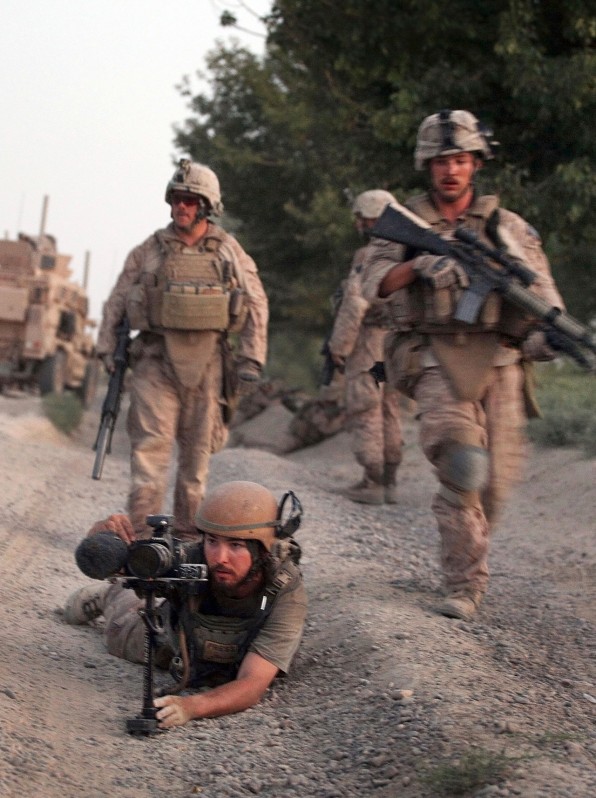Where Can I Watch Here Comes Miss Modern Part 2
I'm standing in Marine Corps Base Camp Pendleton, struggling to get my bearings. A group of Marines huddles in front of me, but I can't quite hear what they're saying, so I turn around and look for something more interesting. All I find is a pile of chairs and other junk. I wonder what it's doing there. And that's when I hear the gun shots.
In reality, I'm in Manhattan, sitting in a comfortable black office chair with headphones on and a virtual reality simulator called the Oculus Rift strapped to my face like a pair of ski goggles. But I still feel a real sense of danger as I spin my chair to look for the shots' source.
And that is exactly the point.

The creator of this video is Danfung Dennis, who is best known for Hell and Back Again, a film he directed about the war in Afghanistan. Dennis was inspired by war photographers like Huynh Cong "Nick" Ut, whose famous photograph of children running away from their burning village after a napalm attack seared an image of the war's cost into the minds of Americans. But even as Dennis's own footage from a far-off war was nominated for an Oscar, he didn't feel that it had accomplished what he wanted it to. "I wanted people to witness it first hand," he says. "I wanted to bring people into the story and let them see it. I maybe naively believed that images could change the world. It's not like [the "napalm girl"] image hasn't been taken in Iraq and Afghanistan. It's been taken so many times that it no longer has any impact on how we react to war. It's so abstract, it's so far away, so distant."
His frustration bred an obsession with immersive video. Four years ago, he started a company called Condition One that built technology to play 180-degree videos on the iPad and iPhone. If viewers moved their phones to the right, they would see what someone inside the scene would see if she turned her head to the right. Meanwhile, the company Oculus VR created a headset that costs $300, giving virtual reality the potential to expand to the masses (such headsets previously cost tens of thousands of dollars are were primarily used for military simulations). Condition One pivoted and started working on a virtual reality short film called Zero Point. The footage I'm watching is from that film.
Zero Point, Dennis says, will explore the world of virtual reality using scenes not only from Camp Pendleton, but also from the trade floor of the E3 video game convention in Los Angeles, and from an animated version of the international space station. It is not about war, but it's part of an effort to establish a medium that Dennis thinks could more accurately portray it. Condition One used a 360-degree, 3-D camera set-up to capture the footage and created a video engine that could stitch together all of those viewpoints–every angle, plus a separate camera for left- and right-eye views–into a seamless virtual reality environment.
The short film is due out this spring for developers (the consumer version of the Oculus Rift has not yet been released). In it, there will be interviews with virtual reality experts from Stanford and USC, independent game developers, and the founder of Oculus VR (Dennis describes Oculus VR as a "partner" in the film, but says it didn't provide funding). There will be a fictional dystopian storyline about where virtual reality could lead if people start spending all of their time in it. And all of this will take place in different corners of the space station, a solution that Dennis developed to avoid the abrupt cut.

Which is all to say, it sounds like what might happen if a documentary about virtual reality were crossed with the Matrix.
If that premise seems unusual, there's a reason for that. Something strange happens to filmmaking when you plop the audience inside of the story. All of the sudden, you can't tell them what to look at. You can't take them from one scene to the next without creating the feeling that they've teleported. Everything you learned in Film 101–the frame, the cut–is essentially useless.
"You are no longer looking at a painting on the wall, you are looking inside the painting," Dennis says. "It's like having a new color in your palette. It's many colors." The most obvious of those new colors is potent empathy. "You automatically care about yourself and your own well-being. All the sudden, if you're someone else, you care about that person," Dennis says. "Instantly now, you are the character, and you care about yourself, empathize with yourself, so you'll be able to develop a sense of immediate connection to that character, because it's you."
Researchers have already begun experiments that seem to back this theory up. A Stanford University associate professor, for instance, had students hold an object that felt like a chainsaw while watching virtual reality footage of a tree being chopped down. On the way out, when an assistant knocked over a glass of water, those students used fewer paper towels than students who had watched plain video of a tree being chopped down.
In the context of a film, this component could get a little more interesting. Maybe the film includes a running internal dialogue for the character you play in it. Maybe that character is a serial killer.
Meanwhile, the story in a virtual reality film is more likely something that happens around you instead of a linear plot. "You are just amidst the story happening, and you might not get every single piece that advances it, but you get parts of it," Dennis says. "It's the same way that if you're in the real world, any two people at the same event will have a slightly different experience of it."
The Zero Point demo ends with a shot from the E3 video game conference, and so far, that's the industry that has paid most attention to the Oculus Rift. The device maker's tag line is "a technology company revolutionizing the way people experience video games."
Dennis is betting it can revolutionize the way people experience video as well. It's difficult to tell from the footage exactly what the complete version of Zero Point will look like, let alone the entire future of films. But one thing is certain: when the screen goes blank and I remove the headset, what I've seen has changed the way I think about it.
Where Can I Watch Here Comes Miss Modern Part 2
Source: https://www.fastcompany.com/3026538/watch-what-happens-when-you-become-part-of-the-movie-youre-viewing
0 Response to "Where Can I Watch Here Comes Miss Modern Part 2"
Post a Comment